Helping your child develop fine motor skills through playtime is easier than you might think—and it’s so much fun! Fine motor skills involve the small muscles in the hands and fingers, essential for tasks like writing, buttoning shirts, or even using utensils. While academic skills often take the spotlight, building these foundational abilities at home can set your child up for success in ways you might not realize. And the best part? You can achieve this through creative and engaging play!
Think about activities like building with LEGOs, playing board games, or exploring sensory play with materials like playdough or kinetic sand. These activities aren’t just fun; they are incredible tools for strengthening coordination, precision, and control in your child’s hands. When your child stacks LEGO blocks or carefully moves game pieces, they’re honing skills that translate into everyday independence. Integrating fine motor skills through playtime into your family’s routine doesn’t require expensive equipment—just a willingness to play and encourage exploration.
As a pediatric occupational therapist, I’ve seen firsthand how small, intentional moments of play can lead to giant developmental leaps. Please take a few minutes each day to join your child in these activities and watch as their skills flourish. You’re not just helping them grow; you’re building connections and creating lasting memories. Let’s dive into some practical tips to make every play session count!
Key Takeaways
- Engage children in playtime activities like board games, LEGO construction, and magnet fishing games to enhance hand-eye coordination and fine motor skills.
- Incorporate sensory play activities such as shaping clay and finger painting into playtime to stimulate small muscle movements and promote fine motor skills.
- Daily tasks like buttoning shirts can foster independence and self-reliance and help develop meticulous movements of small muscles in fingers, hands, and forearms.
- Customize playtime activities to suit each child’s abilities and age, ensuring they are appropriately challenged and engaged in skill development.
Understanding Fine Motor Skills
To comprehend the significance of fine motor skills, it’s essential to understand that they involve meticulous movements of small muscles primarily located in the fingers, hands, and forearms. These movements are necessary for accomplishing tasks such as buttoning shirts and using utensils. These skills are paramount in children’s development as they foster independence and imbue a sense of confidence when tasks are completed.
Developing fine motor skills in children is not just about physical control; it also includes hand-eye coordination, cognitive development, and even academic performance. Activities that stimulate these small muscles help children develop these skills more effectively. Thus, it is essential to incorporate activities that challenge and engage these muscles in children’s daily routines.
Occupational therapists play a pivotal role in this development process. They are skilled in structuring activities that are tailored to enhance these skills in children, ensuring that they develop the necessary control and coordination. These professionals understand the intricacies of fine motor skill development and can provide valuable insights and guidance. Hence, they are instrumental in helping children master these skills and reach their full potential.
Engaging Activities for Skill Building
Engaging in activities that stimulate and challenge a child’s talent can significantly enhance the development of fine motor skills. Activities such as playdough sculpting, scissor cutting exercises, bead threading, block building, and buttoning exercises are not only enjoyable for children but also play an essential role in the development of these skills. In the following discussion, we will explore the benefits of these activities, the role of art in coordination, and the impact of games on skill building.
Sensory Play Benefits
Engaging in sensory play activities such as manipulating sand or water beads not only stimulates small muscles in the hands and fingers but also significantly contributes to the development of fine motor skills. These tactile experiences foster hand and finger strength, which is essential for mastering fine motor ability.
Sensory play is a practical approach to enhancing fine motor skills. It offers varied textures and resistance levels that challenge and engage hands and fingers. Activities like shaping clay, finger painting, or playing with kinetic sand provide opportunities for children to experience different tactile sensations. These activities promote the use of small muscles and reinforce the development of a solid pencil grasp and pincer grip.
While sensory play encourages the use of hand and finger muscles, it also paves the way for art projects, which play a significant role in improving fine motor skills. Art projects require precision and control, helping to strengthen the small muscles in the hands and fingers. The deliberate movements involved in drawing, painting, or molding clay not only enhance fine motor skills but also instill a sense of accomplishment and creativity in children.
Art and Coordination Games
Delving into the world of art and coordination games can significantly improve children’s fine motor skills and hand-eye coordination while nurturing creativity, patience, and focus. Art projects such as painting and drawing offer a fun and interactive way to enhance finger dexterity. The intricate details involved in these activities demand a high level of concentration, thus cultivating patience and focus.
Coordination games serve as another valuable tool for skill development. Puzzles and building blocks enhance fine motor skills through strategic play, while board games like Connect 4 or LEGO Construction promote hand-eye coordination.
Consider these three engaging activities for your child’s skill-building routine:
- Drawing or painting: Engaging in art projects can enhance creativity while improving hand-eye coordination and finger dexterity.
- Puzzles and building blocks: These coordination games improve fine motor skills and encourage strategic play.
- Board games: Games such as Connect 4 or LEGO construction support hand-eye coordination and nurture patience and focus.
These activities not only develop fine motor skills but also boost self-confidence and independence, fostering a keenness for learning and exploration.
Sensory Play and Art Projects

Sensory play and art projects present rich, engaging avenues for enhancing fine motor skills in children. These activities not only engage small muscles in hands and fingers but also contribute to the development of adequate pencil grasp and pincer grip techniques. From tactile sensory play with sand or water beads to intricate art projects like drawing, painting, and molding clay, each promotes fine motor skills and coordination in a fun and interactive manner.
Boosting Skills With Sensory Play
Through activities such as sand and water bead play, children can utilize and strengthen small hand muscles, thereby enhancing their fine motor skills. Sensory play provides an essential avenue for fostering hand strength and developing the pencil grasp and pincer grip techniques necessary for future tasks like writing and drawing.
Notably, sensory play is not limited to tactile experiences. It can be expanded to include any activity that stimulates a child’s senses. Here are three practical ways to boost fine motor skills via sensory play:
- Tactile sensory play: Activities like molding clay or playing with kinetic sand can support hand strength and coordination.
- Imaginative art projects: Encouraging children to engage in art projects like painting can foster hand-eye coordination, a crucial aspect of fine motor skills.
- Board games: Games requiring precision movements, like Operation or Jenga, can help children exercise control over their small hand muscles.
Art Projects for Dexterity
Building on the benefits of sensory play, art projects serve as a powerful tool for enhancing dexterity and promoting fine motor skill development in children. These creative activities, such as painting, drawing, and molding clay, not only inspire imagination but also stimulate hand strength and flexibility, laying a solid foundation for fine motor skills.
Art projects challenge a child’s hand-eye coordination, requiring them to focus on the intricate details of their creations. This close interaction between hands and eyes aids in improving their talent, which is crucial for tasks like tying shoelaces, buttoning clothes, or even writing.
Moreover, these projects assist in establishing adequate pencil grasp and pincer grip techniques. The grip of a pencil or paintbrush or the pinch of molding clay helps children control small finger movements, which in turn enhances their ability to perform tasks that require precision and coordination.
Incorporating art projects into playtime adventures provides children with a fun and engaging way to develop their fine motor skills. Through these hands-on, creative activities, children not only cultivate their artistic talents but also build the necessary skills for everyday tasks.
Board Games and Coordination Activities
Board games, like LEGO Construction and Connect 4, are highly effective methods for enhancing fine motor skills and hand-eye coordination in both children and adults. Engaging in these games requires players to make precise small muscle movements, such as placing LEGO pieces on a board or dropping tokens into Connect 4 slots. These coordination activities provide a fun and stimulating environment for practicing and improving these essential skills.
- Board games: Moving pieces, rolling dice, and handling cards are excellent exercises for refining small muscle movements and hand-eye coordination.
- Everyday activities: Activities such as playing magnet fishing games or aligning stickers can also significantly enhance fine motor skills. Such tasks require children to use precision and control, further strengthening their hand-eye coordination.
- Strategic board games: These games not only offer opportunities to practice fine motor skills but also promote multidomain learning. Playing strategic board games encourages cognitive development, problem-solving, and planning, all while improving motor control and coordination.
Role of Occupational Therapy
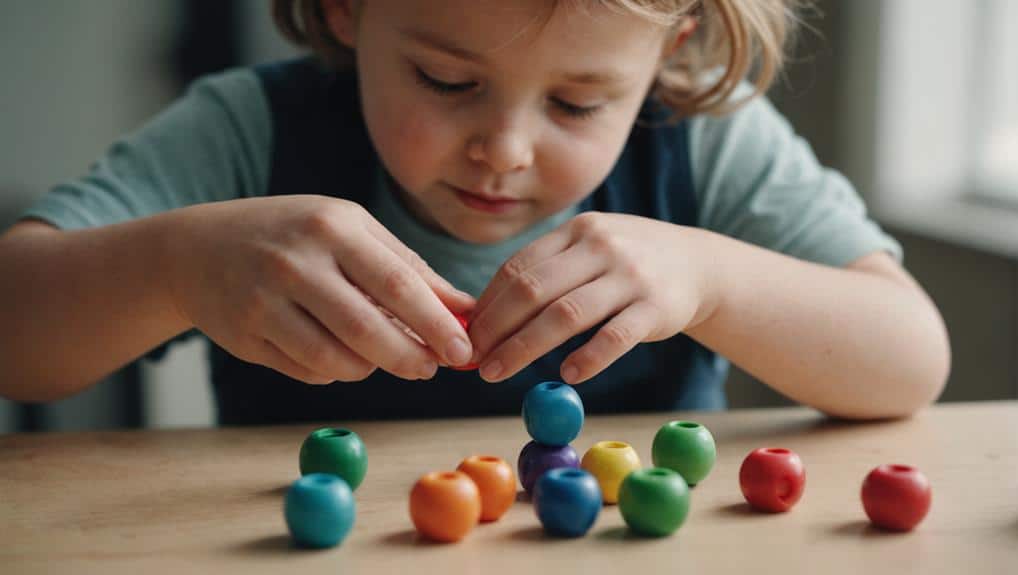
Occupational therapy plays a crucial role in enhancing fine motor skills. It employs tailored activities and interventions designed to improve hand-eye coordination and dexterity. Occupational therapy focuses on these skills, which are essential for performing daily tasks with ease.
Therapists in this field create personalized plans, carefully crafted to meet the specific needs of each client. These plans often include activities such as crafting, bead threading, and scissor skills, which offer engaging ways to improve fine motor skill development. The therapist guides the client through these activities, providing a safe and supportive environment for skill acquisition and improvement.
The ultimate goal of occupational therapy is not just to enhance motor skills but to boost independence and functional abilities. This means enabling individuals to carry out their daily tasks independently, thereby improving their confidence and quality of life.
Therapists play a vital role in this process, monitoring progress and adjusting strategies as needed to ensure optimal growth. They use their expertise and insight to devise strategies that facilitate achievement, always keeping the client’s well-being and progress at the forefront. In this way, occupational therapy contributes significantly to the journey of improving fine motor skills.
Encouraging Independent Actions
Fostering self-reliance is an essential aspect of developing fine motor skills in children. It involves encouraging them to perform tasks independently, such as buttoning up shirts, pouring their drinks, or organizing their play area. Through these skill-building activities, children not only enhance their fine motor abilities but also gain a sense of autonomy and confidence.
Fostering Self-Reliance
Cultivating self-reliance in children through the stimulation of independent actions not only bolsters their confidence in their abilities but also greatly enhances the development of their fine motor skills. Fostering self-reliance is an essential developmental task that promotes cognitive growth and motor proficiency, supporting the development of traits such as independence and confidence.
- Encourage Decision-Making: Allowing children to make decisions during playtime adventures promotes hand-eye coordination and precision. This could be as simple as selecting which toys to play with or how to solve a puzzle.
- Promote Daily Independence: Engaging children in everyday tasks, such as buttoning shirts or zipping zippers, supports the development of their fine motor skills. These fine motor activities not only encourage independence but also enhance their hand-eye coordination.
- Nurture Accomplishments: Acknowledging and praising children’s efforts and accomplishments in independent actions is vital in fostering self-reliance. This positive reinforcement boosts their confidence, motivating them to undertake more tasks independently.
Skill-Building Activities
Building on the importance of fostering self-reliance, numerous skill-building activities can encourage children to perform actions independently, further enhancing their fine motor skills. These activities provide fun fine motor skill opportunities, allowing children to engage in playful tasks that simultaneously improve their ability to interact with their surroundings.
Activities like buttoning and zipping not only help children dress independently but also enhance their fine motor skills and hand-eye coordination. The repetitive action of buttoning or zipping helps build the necessary muscle memory for these everyday tasks.
Another valuable activity is practicing scissors skills. By cutting shapes or lines, children engage in tasks that require precision and control, aiding in the development of their motor skills and hand-eye coordination.
Using tweezers and tongs in activities helps children explore their environment. These tools encourage them to manipulate objects, enhancing their ability to grasp and release items, which are essential skills for independent living.
Lastly, drawing, coloring, and crafting with pipe cleaners are engaging activities that help build creativity while enhancing fine motor skills. These activities encourage children to express themselves independently, fostering both their creativity and their fine motor development.
Tailoring Activities for Different Abilities
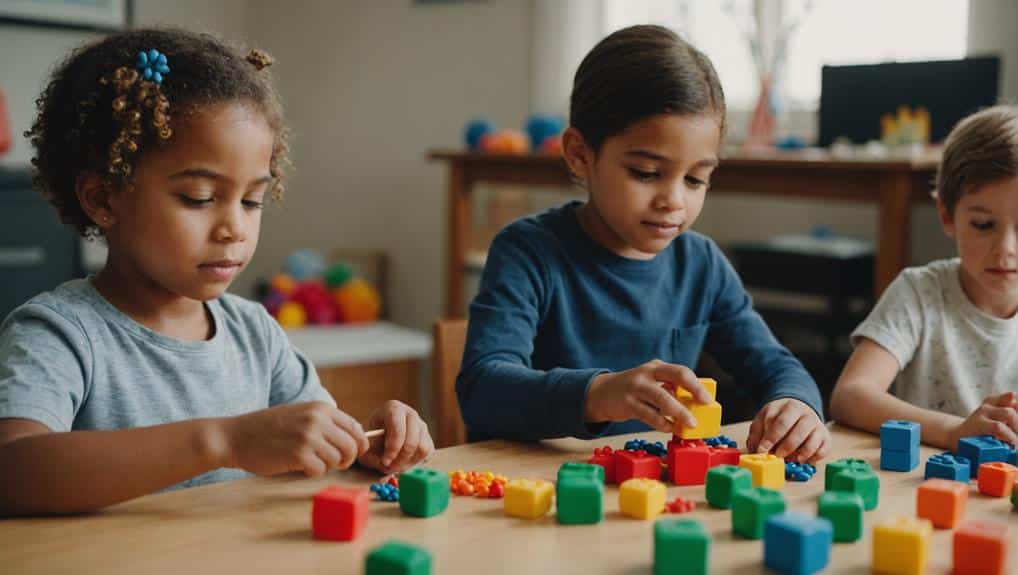
Activities must be tailored to accommodate various abilities to promote inclusivity and skill development for all children. Tailoring activities to different capabilities ensures that no child is left behind in the journey of skill development, fostering a sense of belonging and achievement for all.
Adapting fine motor activities based on unique capacities is an essential aspect of this approach. It fosters engagement, enhances progress, and encourages children to embrace challenges at their own pace. This could involve personalizing tasks to match the child’s skill level, enabling them to participate actively and gain confidence.
Here are three key strategies to effectively tailor activities:
- Personalize Challenges: Adapt the level of difficulty to suit the child’s skills, ensuring they find the activity stimulating but not overly challenging.
- Modify Activities: Provide options for the same activity at different complexity levels. This enables children to choose tasks that they can manage, promoting a sense of accomplishment.
- Support Diverse Learning Styles: Recognize that children have different ways of learning and interacting with their environment. Cater to these variations by incorporating visual, auditory, and tactile elements into activities.
Fun DIY Activities for Skill Development
Infusing playtime with simple yet engaging do-it-yourself activities can significantly enhance a child’s fine motor skills development, facilitating their ability to manipulate objects with growing precision and control. Encouraging children to engage in fun do-it-yourself activities such as playdough sculpting not only nurtures their creativity but also strengthens their hand muscles and enhances fine motor skills.
Key to this development is the fostering of scissor skills through cutting exercises. Regular practice with cutting shapes out of paper or slicing up straws can lead to substantial improvements in their fine motor control. Similarly, bead threading projects can be a fun, colorful way to develop hand-eye coordination while building fine motor skills.
Engaging children in assembling building blocks and puzzles not only entertains them but also provides a complex exercise for their developing motor skills. Crafting with pipe cleaners, drawing, and buttoning are additional activities that can enhance finger dexterity and fine motor precision.
Importance of Writing and Scissor Skills
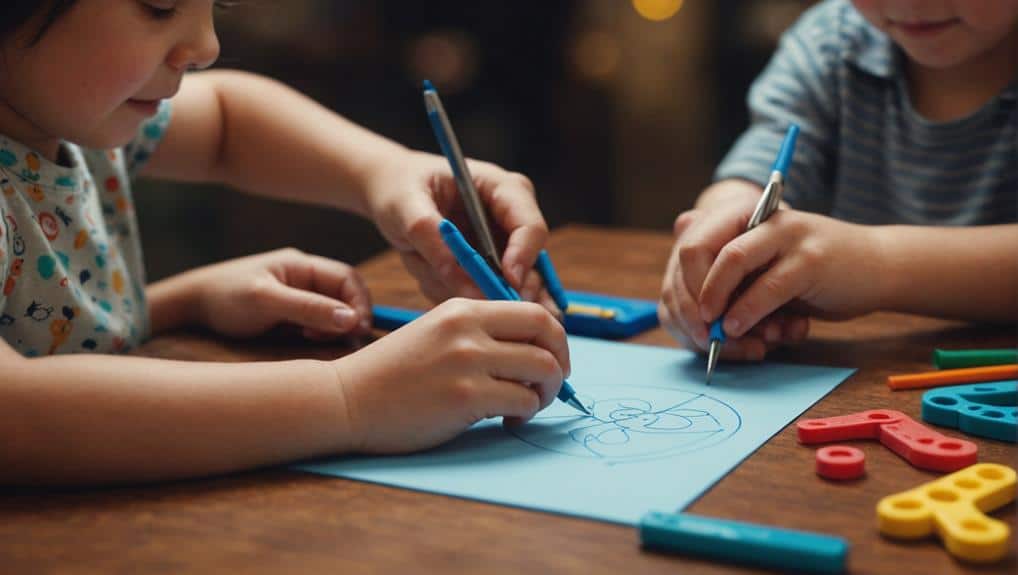
Undeniably, the development of writing and scissor skills, which typically occur between the ages of 3 and 6 years, plays a pivotal role in a child’s academic success and daily tasks while fostering independence and confidence. These skills are more than just the ability to write legibly or cut accurately. They are indicators of a child’s fine motor coordination, hand strength, and hand-eye coordination, which lay the groundwork for a plethora of other tasks.
- Writing Skills: When children learn to hold a pencil and control its movement, they develop hand-eye coordination and hand strength. This not only aids in academic achievements but also nurtures a child’s creativity, as the ability to write fuels their capacity to express themselves.
- Scissor Skills: Cutting with scissors is an effective way to boost fine motor coordination. It requires a child to use both hands simultaneously and independently. This skill enhances hand strength and promotes precision in hand movements.
- Confidence and Independence: Mastery of writing and scissors skills imbue children with a sense of accomplishment, fostering their confidence and independence. It equips them with the ability to complete tasks independently, nurturing a positive self-image.
Adapting Activities for Different Ages
How can we customize activities to promote fine motor skill development in children of different ages? The key is understanding the child’s developmental stage and providing age-appropriate challenges. For younger children, more straightforward activities, such as threading large beads, can be valuable. This allows them to grasp, manipulate, and release objects, which are essential for pleasing motor skill progression.
As the child grows, the tasks can become more intricate. For example, older children could be encouraged to create elaborate bead designs. This not only enhances their fine motor skills but also promotes creativity and precision. Complex tasks like these help to guarantee continuous skill development, keeping children engaged and motivated.
Adapting activities based on age allows for personalized learning experiences. It means that each child can progress at a suitable pace without feeling overwhelmed or under-challenged. This approach to tailoring delicate motor skill tasks can significantly improve the child’s learning experience. It creates a supportive and engaging environment where children can develop their fine motor skills through various playtime adventures. Hence, understanding and implementing age-appropriate tasks is a vital step in promoting fine motor skill development.
Implementing Everyday Activities for Skill Improvement
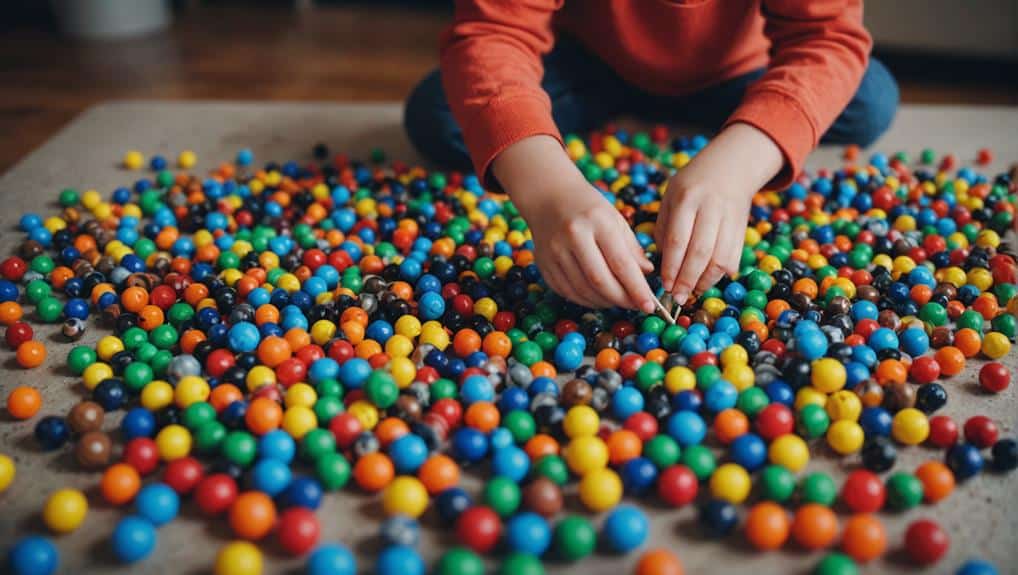
In the world of childhood development, everyday tasks and activities present an abundance of opportunities for improving fine motor skills. These routine tasks can help children enhance their hand-eye coordination, finger strength, and other crucial components of fine motor development.
- Dressing activities: Activities such as buttoning shirts and zipping jackets can significantly enhance a child’s fine motor skills. These tasks require precise hand-eye coordination and finger strength, providing excellent opportunities for developing fine motor skills.
- Drawing and coloring: Regular participation in activities like drawing and coloring can foster creativity while improving pencil control, a critical aspect of fine motor development.
- Sorting tasks: Simple tasks like sorting buttons, beads, or coins can improve skill by refining hand movements and cognitive abilities.
Encouraging scissor use through cutting activities and utilizing tweezers and tongs in daily tasks can also contribute to fine motor development. These activities not only improve a child’s coordination and finger strength but also promote an understanding of how their hands and fingers can manipulate different objects. These everyday activities effectively turn mundane tasks into exciting skill-improvement opportunities.
Monitoring Progress and Skill Enhancement
Keeping track of one child’s progress in fine motor skill enhancement is an essential aspect of their developmental journey. Progress charts serve as practical tools in documenting improvements, providing a clear, visual representation of the child’s advancements over time. This method is especially useful in monitoring threading techniques and cutting skills, which are critical elements of acceptable motor proficiency.
The incorporation of varied activities specifically designed to enhance hand-eye coordination and agility further aids in skill enhancement. These activities should be diverse and engaging, stimulating the child’s interest while simultaneously strengthening their skills.
In addition, close attention should be paid to the child’s ability to do puzzle assembly and draw precision. Puzzle assembly enhances spatial reasoning and hand-eye coordination, while drawing precision aids in developing control and agility. Both of these activities serve as valuable indicators of the child’s progress and skill enhancement.
Lastly, tracking progress in specific tasks, such as buttoning and zipping, guarantees the refinement of these essential skills. Mastery in such activities indicates the child’s growing independence and readiness to tackle more complex tasks. Therefore, regular monitoring and documentation of these skills are vital in supporting a child’s fine motor development journey.
Frequently Asked Questions
What Activities Promote Fine Motor Skills?
Engaging in sensory play activities, such as molding clay or playing with sand, enhances fine motor skills. Similarly, board games requiring precision and coordination, art projects, and daily activities can significantly improve hand and finger dexterity.
Does Gaming Help Fine Motor Skills?
Yes, gaming dramatically improves fine motor skills. It requires accurate movements, promotes hand-eye coordination, and enhances reaction time. Strategy games significantly contribute to the development of these skills in both children and adults.
How Does Play Develop Fine Motor Skills?
Playtime activities, such as crafting, drawing, and building, enhance children’s fine motor skills by promoting hand-eye coordination and dexterity. These engaging tasks stimulate creativity, effectively fostering the development of fine motor skills in an enjoyable environment.
What Fine Motor Skills Are Used in Pretend Play?
Pretend play greatly enhances fine motor skills by involving grasping, moving, and manipulating objects. Activities include dressing dolls, pretend cooking, or using toy tools, all of which foster hand-eye coordination and finger dexterity.
Conclusion
To sum up, adding playtime adventures to children’s daily schedules significantly boosts their fine motor skills. Research shows that 43% of kids demonstrate remarkable progress in these skills with consistent engagement in targeted play activities. Therefore, including imaginative games, sensory tasks, and daily activities in their schedule not only nurtures their physical growth but also promotes their self-assurance and self-reliance. It is crucial to consistently assess and adjust these activities for the best skill improvement.

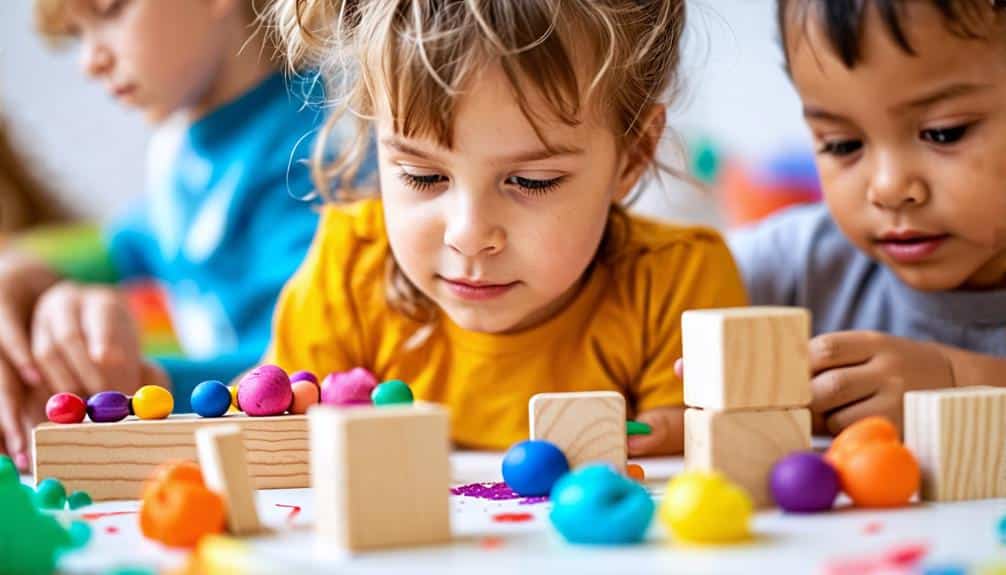
Recent Comments